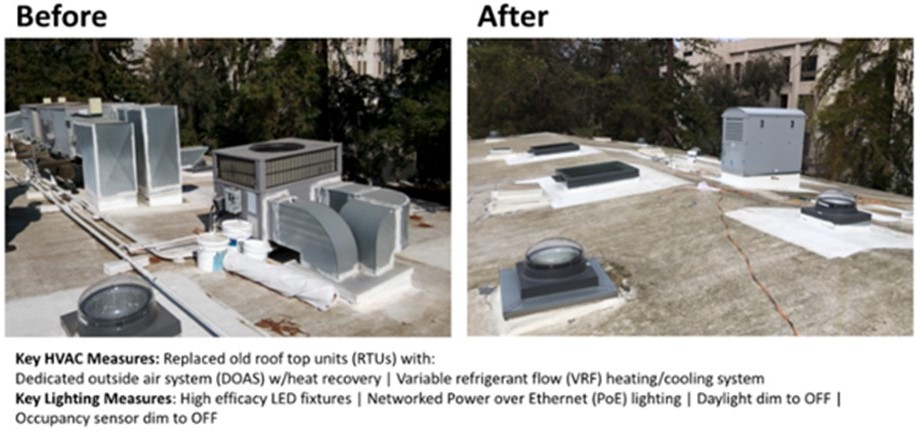Project Info
COMPLETE
 Project Title
Project Title
 Project Title
Project Title
Retrofit DOAS, VRF and Networked Lighting Controls Demonstration: UC Davis Facilities Management, Energy Conservation Office
Project Number CR16PGE1070 Organization PG&E End-use HVAC, Lighting, Plug Load, Whole Building Sector Commercial Project Year(s) 2016 - 2020Project Results
The primary HVAC findings from this project are:
- Overall, the building used 58% less annual energy after the 2017 retrofit than before the retrofit with similar savings when compared to a 2019 Energy Code baseline HVAC system.
- The field-estimated thermal efficiency of the VRF system installed at the site was consistent with average operational performance simulated by California's energy code compliance software, CBECC-Com. CBECC-Com simulates part-load VRF performance based on the rated EER at full load and fixed part-load performance curves.
- For the VRF system installed at the site, rated EER was representative of field-estimate thermal efficiency. The part-load rating, IEER, was not found to be representative of most measurements with performance dropping off at high and low outside air temperatures.
- Two different VRF fan coil fan speed control modes were tested: “Automatic” mode where fan coils vary their speed between high, medium, and low speeds automatically based on room temperature and run continuously at low speed when the fan coils are not actively heating or cooling and a “Custom” mode where VRF fan coil fans operate at medium speed and only when the fan coils are actively heating or cooling. Controlling the fans in this Custom mode resulted in the fan coil fans using approximately 60% less fan energy than operating the fan coil fans in “Automatic” mode.
- The VRF system utilized heat recovery, which allows for simultaneous heating and cooling in multiple zones at the same time. Though heating/cooling load recovery occurred fairly often, the amount of load recovered was relatively low and did not have a significant impact on energy savings.
- Implementing demand control ventilation using a return air sensor at the HRV return air intake proved to be a viable method of keeping carbon dioxide below the recommend limit for occupied spaces for this building.
- Implementing unoccupied VRF temperature setpoint setback, as opposed to turning off the VRF system during unoccupied hours, provided a moderate reduction on morning warm up demand but resulted in a substantial increase in energy use.
- The decoupled ventilation and heating/cooling system provided acceptable levels of occupant thermal comfort, based on measured space CO2 trends and occupant survey results.
- Implementing night ventilation for pre-cooling through the dedicated outside air system provided a moderate reduction in VRF morning power demand. However, the increase in DOAS energy use required to operate in night ventilation mode was greater than the VRF morning energy savings.
The primary lighting findings from this project are:
- The general lighting provided by solid state lighting using Power over Ethernet technology achieved an average of 0.32 watts per square foot while providing appropriate levels of illumination recommended by the Illuminating Engineering Society (IES) for office spaces. This resulted in saving 69% of the energy compared to the pre-retrofit lighting power. Supplemental task lighting was provided but had a negligible impact on energy consumption.
- Findings did not provide sufficient evidence for recommending significant changes to the existing exceptions in the current Title 24, Part 6 that exempt spaces with glazing areas less than 24 square feet from automated daylighting controls.
- Occupants accepted shorter occupancy sensor-controlled shut-off time delays. Current Title 24, Part 6 requires shut-off of 20 minutes or less. Luminaire Level Lighting Controls (LLLC) make shut-off time adjustments more customizable for changing needs and layouts of office spaces. The additional savings from reducing the shut-off time delay to 10 minutes in this demonstration was 4.8%.
Project Report Document
Loading PDF Preview...
